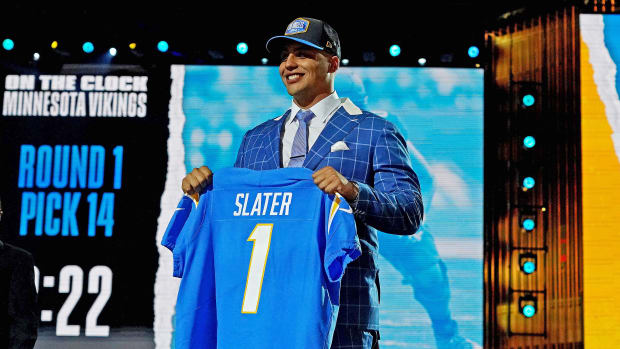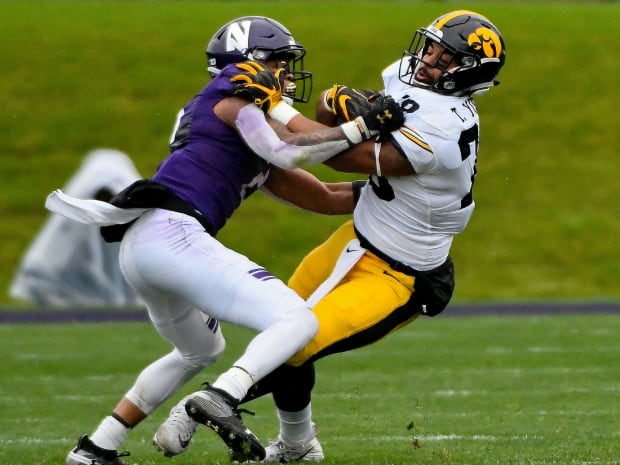After having two players drafted in the first round for the first time, Northwestern football continues to transform.
Growing up in Ohio in the 1950s, Ron Burton always expected to be the star running back at Ohio State. Woody Hayes recruited him and there was mutual interest until Ara Parseghian, the new head coach at Northwestern, convinced Burton to come to Evanston where he’d have the opportunity to try to beat Hayes.
At the time, this was a major gamble: Northwestern was coming off of a winless season and had a new coach. But Burton bet on himself, and the Wildcats ultimately beat Hayes and the Buckeyes 21–0 in ’58. However, that didn’t exactly usher in a new era for the program. Over Burton’s four years, Northwestern went 15-20-1.
In ’60, Burton became just the third Wildcat to be a first-round NFL draft pick when the Eagles selected him ninth. In the 60 drafts since, you can count the number of first-round NFL picks from Northwestern on one hand.
So when the Wildcats saw offensive lineman Rashawn Slater (No. 13 to the Chargers) and cornerback Greg Newsome II (No. 26 to the Browns) drafted in Thursday’s first round, the first time the program has ever had multiple first-rounders in the same draft, it put Northwestern in an unfamiliar spotlight.
“We have a belief here that we want to be the best player development staff in the country,” current Northwestern coach Pat Fitzgerald says. “To see this happen where you’ve got a top 10 academic reputation, you’ve got a top 10 football team and now I have multiple guys developed to be first-round picks, I think it makes a statement that you can have it all here at Northwestern.”

When Burton’s son Steve came to play football for Northwestern in 1980, the program was at an all-time low. Over Steve’s first two years, the Wildcats were 0–22.
“When I got there, they barely had a weight room,” Burton says. “I’m like, ‘Whoa, where’s our weight room? This is our weight room?’”
Between ’72 and ’94, Northwestern didn’t have a single winning season. Then in ’95, the program won the Big Ten before losing to USC in the Rose Bowl. Still, it was a major step in the right direction. Over the next 10 years, the program oscillated between success and mediocrity.
In July 2006, Fitzgerald, a key cog to the ’95 and ’96 Big Ten championship teams, became the new head coach, following the unexpected death of Randy Walker due to a heart attack. Despite the program experiencing more success in the previous decade than Northwestern had seen in quite some time, Fitzgerald had his work cut out for him.
“First of all, we wanted to develop a set of values that we could believe in and be our roadmap,” Fitzgerald says. “Number two, we wanted to really look hard at our recruiting and recruiting great athleticism, great length, speed, positional fit; but then, stay true to who we are and stay true to the fit of the type of young man and type of family we’re looking to recruit.”
Some of these values Fitzgerald preaches might seem clichéd: “Choosing to have a great attitude every moment of every day; relentlessly investing in improvement every single day; bring[ing] in character guys that could be trustworthy not some of the time but all the time,” he says.
But oftentimes, something becomes a cliché because it’s true. It’s hard to argue with someone who’s had the level of success that Fitzgerald has had in Evanston. As bowl games became more abundant, the Wildcats appeared in a bowl game in five straight seasons between ’08 and ’12. Though they were victorious in only one of those games, this was uncharted territory—Northwestern had played in only six bowl games before Fitzgerald took over.
In ’18, Fitzgerald reached another major milestone: a Big Ten West division championship. Written off by some as a fluke that year, the Wildcats repeated as west champs two seasons later, continuing to prove what Fitzgerald always believed: At Northwestern, you can have the best of both worlds in the classroom and on the football field.
“We’ve got 20+ states on our roster. We’ve got a melting pot team of races and religions and socioeconomic backgrounds,” Fitzgerald says. “It’s a really unique place. … [It’s] just absolutely a joy and a privilege to be able to work with these kind of guys. I think the hallmark of our program is our brotherhood. The relationships that are formed in our locker room, the way that these guys sacrifice so much for each other is why we’ve been able to be consistent.”
***

Slater and Newsome are two prime examples of Fitzgerald’s vision coming to fruition. Slater, an offensive lineman, decided to sit out ’20 after the Big Ten initially canceled its season in August. He already had his sights set on the NFL.
Newsome wasn’t quite there yet. After missing some of ’19 because of injury, he needed to prove himself. He wasn’t even on the radar as a potential first-round pick. The cornerback then went out and shut down top receivers in the Big Ten, holding opposing quarterbacks to a 31.7 passer rating against him as part of a Northwestern defense that had the lowest opponent team passer rating in college football. Between that and running an unofficial 4.38 40-yard dash at his pro day, Newsome shot up draft boards.
“High character corner,” Fitzgerald says of Newsome. “Great feet. Great hips. High level of compete, as high as you’re gonna maybe see. That’s not just in games. It’s in practice. … He’s a unicorn, man.”
Fitzgerald––and NFL general managers, for that matter––have lavished similar praise on Slater.
“One [general manager] talked to me about Rashawn being, what he feels, is the best fundamental and technical offensive lineman in this year’s draft,” Fitzgerald says.
The 46-year-old coach continues, looking at the bigger picture of his program: “Maybe we aren’t one of the traditional bluebloods, but I don’t think that’s important. What you’re doing now and how you’re developing your players kind of speaks for itself.”
For Steve Burton, who has spent his entire life ensconced in Wildcats football, he recognizes that this isn’t the Northwestern of the past.
“Northwestern’s already on a different level because of the academics, but now, when you got two first-round picks going to the NFL from your football team, it puts you on a higher level,” he says. “It’s a game-changer for the school and the athletic department, and it’s a game-changer for how the league looks at Northwestern.”
And while developing two first-round picks after winning two Big Ten West championships in three years and winning four straight bowl games might seem like Fitzgerald’s crowning achievements, Northwestern’s not there yet.
“We think we’ve got this thing really rolling at an all-time high, and [we] look forward to continuing to take the next steps because we’re far from where we want to be,” Fitzgerald says. “To me, that’s the most exciting thing. We’ve got great excitement around the program, but we’re far from being a finished product.”
More SI.com Coverage:
• Grades for Every NFL First-Round Pick
• What Would a CFB Super League Look Like?
• Why Bryan Harsin Left Boise for Auburn